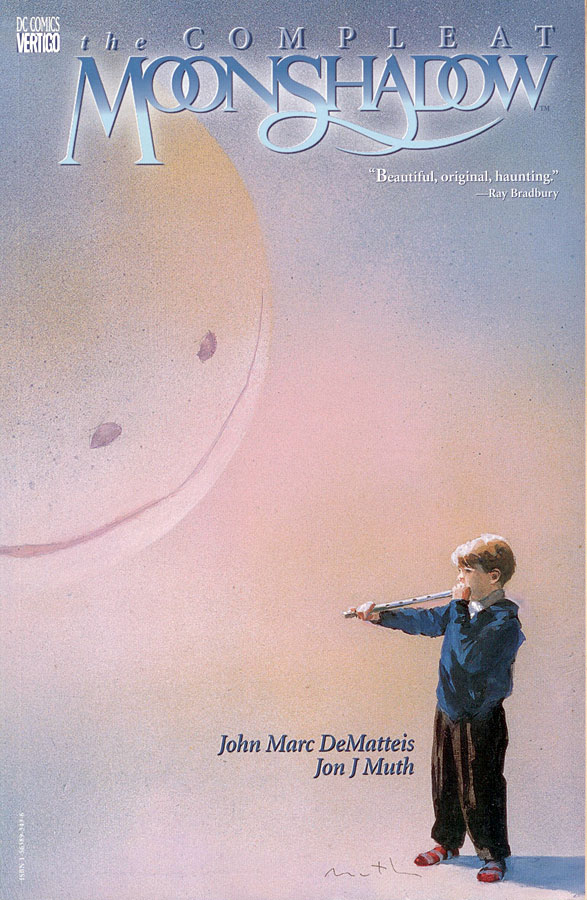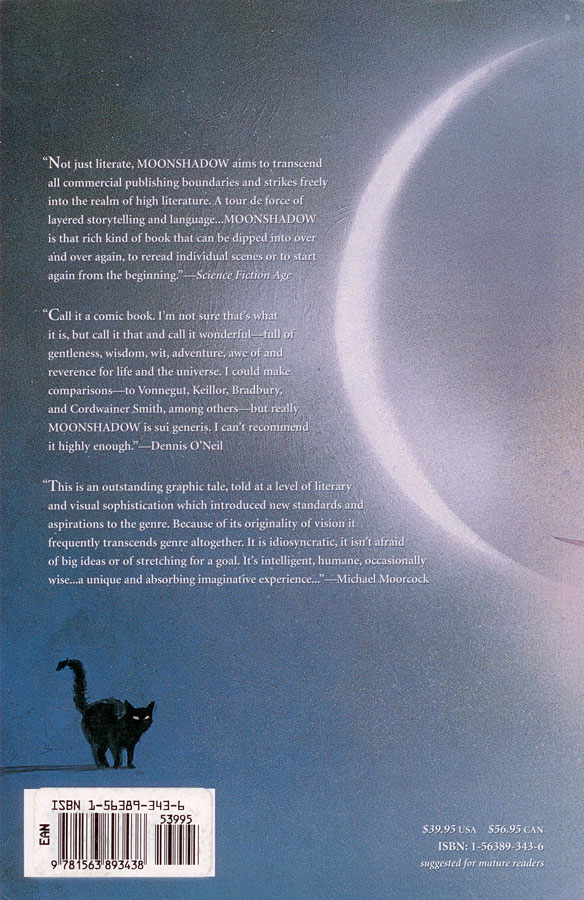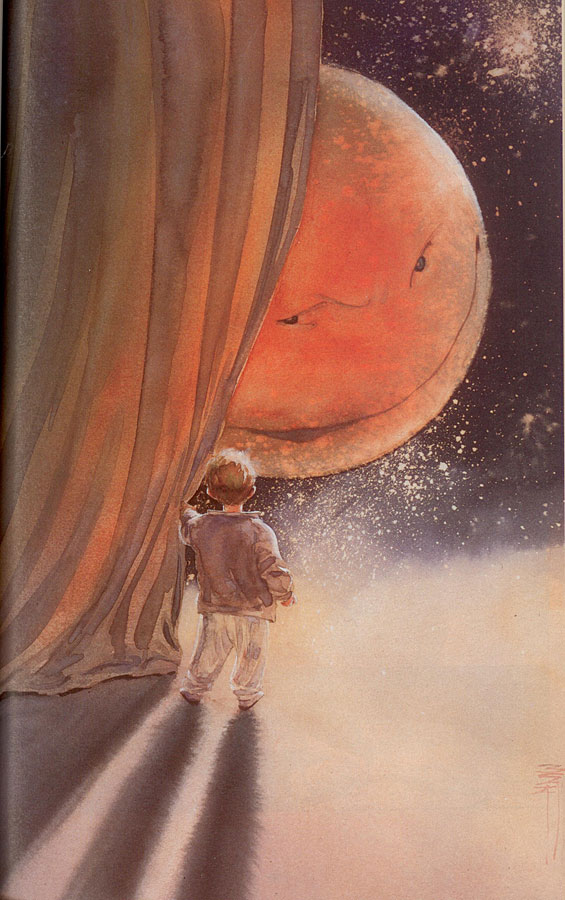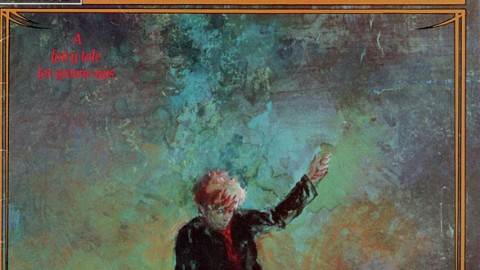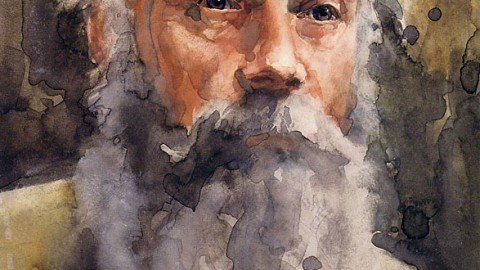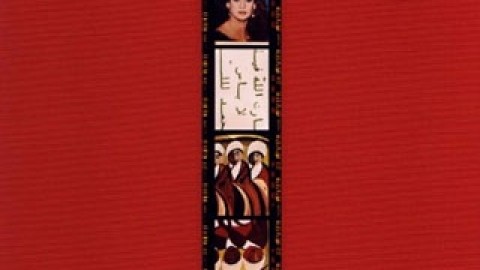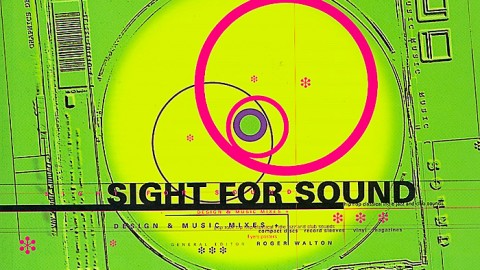DC Comics re-issue of all 12 Moonshadow issues, in paperback format, 468 pages.
All stories by John Marc DeMatteis (writer) and Jon J. Muth (Illustrator).
One of the most ground-breaking and literate comic series of all-time is finally collected in one mammoth volume, showcasing the very best in modern storytelling and painted artwork. This adult fairy tale is a work that evokes comparison with Lewis Carroll & William Blake. Born in an intergalactic zoo and raised on the romantic works of Byron and Shelley, Moonshadow is suddenly kicked out of his home at the age of fourteen into an uncaring cosmos. He embarks on a journey which takes him not only to different planets, but also to the farthest reaches of the human heart.
Book #12 is the part where Muth used pictures of Sylvian as source for the main character.
This book contains the re-issue of chapter #12 with several replacements for the Sylvian character with newly painted figures. Fortunately a lot of David Sylvian can be recognized in the final artwork. Brilliant book!
From Comic magazine:
Before Gaiman there was DeMatteis. Before Ross there was Muth. And before Watchmen there was Moonshadow. It is amazing how we can forget these things. Ezra Pound’s poem ‘Hugh Selwyn Mauberly’ is one of those overlooked pieces of great modernist literature. It could have been marked as one of the great key pieces, and was for a time, but ended up getting overshadowed by two other pieces that came out a year later, Eliot’s ‘The Waste Land’ and Joyce’s Ulysses. John Marc DeMatteis and Jon J Muth’s Moonshadow is in a similar position. Moonshadow came out before both Watchmen and Dark Knight Returns, and this book is outstandingly overlooked in the canon of Comic Book Literature. In his afterword for the Wolverine trade paperback Frank Miller lists Moonshadow as one of the adult/mature comics that was changing the landscape of comics alongside Watchmen. These days, while people hail Watchmen and The Dark Knight Returns left, right and center, Moonshadow is forgotten; not because it is inferior, but (most likely) because it is completely (or compleatly) different form the other two works.
The Compleat Moonshadow is the definitive version of the story, and includes the final chapter, Farewell Moonshadow (which the original Epic trade lacks). The book begins with the story of how Moonshadow’s mother came to be kidnapped from Earth by a member of a erratic and incomprehensible race of happy-faces called the G’l-Doses, and how Moonshadow was born of the coupling of “Sunflower” and her kidnapper.
From there, the story sprawls through Moonshadow’s life, growing ever more wonderful and strange… and heartbreaking. Moonshadow is a character who is easy to identify with, as the variety of his experiences allow almost anyone at one point or another to stop and say “yeah, I know how that feels.” Moonshadow plumbs the depths of human experience, from the joy of falling in love, to suicidal depression, to feeling like an outsider, to the wonder of life itself. These things, along with death, sex, drugs, sex, spirituality, insanity, sex, war, the nature of the universe, and sex, comprise the themes of the book.
Along with a cast of something that can feel like hundreds The Compleat Moonshadow is a prototype of what would come afterwards in the industry
with works like Sandman and Preacher. The writing of DeMatteis in Moonshadow is twice as poetic as that of Gaiman’s in Sandman, and although it has a lighter overall theme there are darker subtexts as Moonshadow deals with what goes on during his two year journey of self-discovery. And to add to the splendor of DeMatteis’ words is the water color paintings of Jon J Muth.
The paintings of Muth in The Compleat Moonshadow range from highly realistic, to cartoonish depending on the characters and the situation. The art denotes a certain maturity, even with the cartoonish aspects, the closer you get to the end the more realistic the paintings are. Muth’s art is an attention
grabber, easily flipping from soft quiet moments to violent revelation to desolate hash wastelands of War. Moonshadow shows Muth’s work at his absolute best, as his ability to bring life to the characters, be it outlandish aliens or pensive humans in a realistic style is virtually unparalleled. His interpretations of the characters suit them perfectly, and the moments he captures them in show them in all their glory.
In comics today most writers drive for a hard scathing edginess, something that cuts to the bone hard and furious, slashing away until it gets to the guts of the issues. If you only read because of the hard edge The Compleat Moonshadow may not be a first pick for you on the surface, but in fact the knife that Moonshadow wields is sharper and can cut deeper than you realize. The only difference is that you don’t notice it at first, the knife is sharper and less painful, the poetry of the words and paintings distract you from the fact that the ideas that are dealt with in Moonshadow are a edgy as any other work out there now.
The most likely reason that Moonshadow was forgotten is because it was out of print too long a time, but in 1998 DC’s Vertigo line finally collected the entire series, including the epilogue, into The Compleat Moonshadow. This book was part of the revolution in comics, and now that it is available again it should be let back into the fold. Next time you’re at your Comic shop pick up a copy, if your store does not have it, or refuses to get it, you should find a better store.

